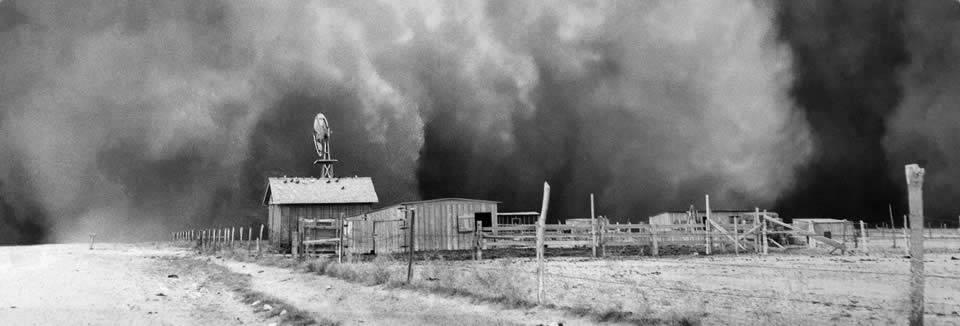
Dust

Earth sifts over things as dirt or dust. If you stay still, earth buries you, ready or not. The debris on the tops of your feet or shoes thickens, windblown dirt piles around it, and pretty soon your feet are underground. Then the ground rises over your ankles and up your shins. If the sergeant holds his platoon at attention long enough, he and his ranks will stand upright and buried like a Chinese emperor's army.Micrometeorite dust can bury you, too, if you wait: A ton falls on earth every hour. Or you could pile up with locusts. At Mount Cook in Montana, at 11,000 feet, you can see on the flank a dark layer of locusts. The locusts fell or wrecked in 1907, when a swarm flew off course and froze. People noticed the deposit only when a chunk separated from the mountain and fell into a creek that bore it downstream.
The rate at which dirt buries us varies. New York City's street level rises every century. The Mexico City in which Cortés walked is now thirty feet underground. It would be farther underground except that Mexico City itself has started sinking. Digging a subway line there, workers found a temple. Debris lifts land an average of 4. 7 feet per century. King Herod the Great rebuilt the Second Temple in Jerusalem 2,000 years ago.
The famous Western Wall is a top layer of old retaining wall near the peak of Mount Moriah. From the present bottom of the Western Wall to bedrock is sixty feet.
Quick: Why aren't you dusting? On every continent we sweep floors and wipe tabletops not only to shine the place but to forestall burial.
It is interesting, the debris in the air. A surprising portion of it is spider legs, and bits thereof. Spider legs are flimsy, Oxford writer David Bodanis says, because they are hollow. They lack muscles; compressed air moves them. Consequently, they snap off easily and blow about. Another unexpected source of aerial detritus is tires. Eroding tires shed latex shreds at a brisk clip, say the folks who train their microscopes on air. Farm dust joins sulfuric acid droplets (from burned fossil fuels) and sand from the Sahara Desert to produce pollution haze that blurs and dims the world.We inhale "many hundreds of particles in each breath we take," says Bodanis. Air routinely carries intimate fragments of run, dung, carcasses, leaves and leaf hairs, coral, coal, skin, sweat, soap, silt, pollen, algae, bacteria, spores, soot, ammonia, and spit, as well as "salt crystals from ocean whitecaps, dust scraped off distant mountains, micro bits of cooled magma blown from volcanoes and carried microfragments from tropical forest fires." These things can add up.
At dusk the particles meet rising water vapor, stick together, and fall: That is when they will bury you. Soil bacteria eat what they can, and the rest of it stays put if there's no wind. After thirty years, there is a new inch of topsoil, which may, however, wash into the ocean.
We live on dead people's heads. Scratching under a suburb of St. Louis, archaeologists recently found thirteen settlements, one on top of the other, some of which lasted longer than St. Louis has. Excavating the Combe Grenal cave in France, paleontologists found sixty different layers of human occupation.
The pleasantly lazy people of Bronze Age Troy co-operated with the burial process. Instead of sweeping garbage and litter from their floors, they brought in dirt to cover the mess and tramped it down. Soon they had to stoop in their rooms, so they heightened their doors and roofs for another round. Invaders, too, if they win, tend to build new floors on roofs they've wrecked. By the nineteenth century, archaeologists had to dig through twenty-four feet of earth to find the monuments of the Roman Forum.
In 1870 - 71 when Heinrich Schliemann was digging, at a site he hoped was Troy, he excavated a trench sixteen feet deep before he found worked stones. He had found the top of a wall twenty feet high. Under that wall's foundation, he learned over years of digging, was another high wall, and - - - oops - - - another, and another. Archaeologists are still excavating Troy.
Elsewhere, the ziggurats of the ancient New East sank into the ground, settled into soft soils, and decomposed. "Every few years, the priests would have them build up a few steps higher to compensate for the sinking of the bottom story into the soil." Earthworm tunnels lower buildings, too, as Darwin noticed. These days the heavy Cathedral of St. John the Divine in New York City is sinking, according to the cathedral's recent writer-in- residence William Bryant Logan, who wrote the excellent book Dirt. The cathedral's base "is now beneath the water table," and "a living spring" has risen in its crypt.
In Santa Monica, California, early every morning, a worker in a bulldozer plows the previous day's trash into the beach. I saw it. He turns the trash layer under as a farmer lashes fields with last year's leaves. He finishes the top by spreading a layer of sand, so the beach, rising on paper and Styrofoam, looks clean.
--- From Abundance - - -
Essays Old and New
Annie Dillard
Read by Susan Ericksen
(Brilliance Audio)